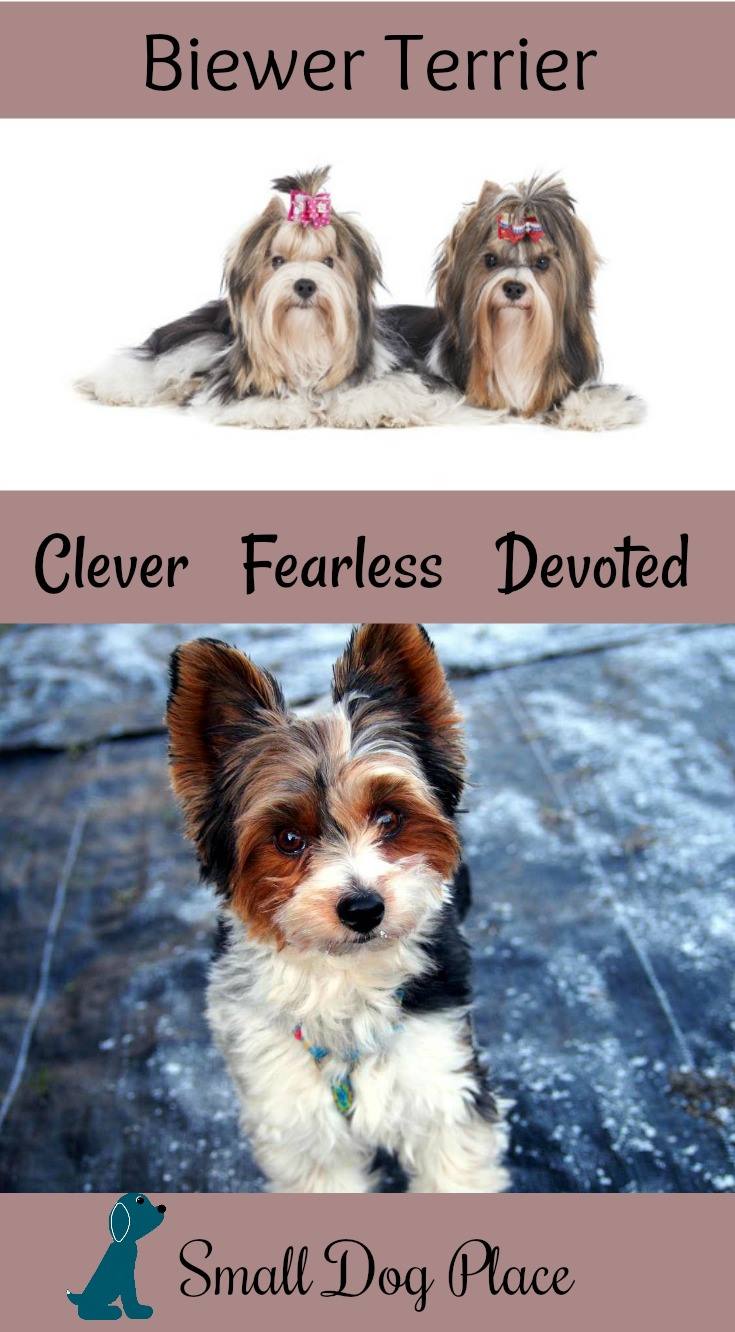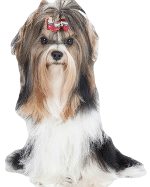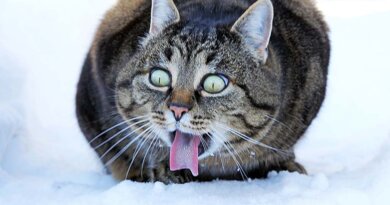Biewer Terrier Breed Information | Small Dog Place
The Biewer Terrier By Janice Jones |Last Updated January 22, 2020
At first glance, the Biewer Terrier looks like a colorful tricolored Yorkie or a hybrid mix between a Maltese and Yorkie (Morkie).

It is neither and to prove it belongs to a breed of its own, the American Kennel Club welcomed them into their Foundation Stock Service Program (FSS) in April of 2014 announcing that there were enough genetic differences to set them apart from the Yorkshire terrier.
Here is a modern breed in the making right before our very eyes.
 The Biewer Terrier – Clever, Fearless, Devoted – Small Dog Place
The Biewer Terrier – Clever, Fearless, Devoted – Small Dog PlacePronounced “Bee-Vair,” the breed was first discovered and developed in Germany by a couple, Werner and Gertrude Biewer, Yorkshire terrier breeders. They mated two of their dogs together in 1984 and produced a blue, gold, and white dog named Schneeflocken von Friedheck. The explanation for this unusual “Yorkie” was a rare recessive piebald gene mutation.
From there it was introduced into the United States in 2003 and continues to gain in popularity as people learn about this incredibly sweet, happy, even-tempered terrier that is a fiercely loyal companion to all those humans he determines are his family.
As a breed distinct from the Yorkie, there are still plenty
of similarities. One major difference
that you will notice immediately is his upturned tail held over his back, covered
with a rich plume of hair.
As you known,
in American, most Yorkies have docked tails, but the Biewer keeps his full tail
as part of the standard began in
Germany. As in many European countries,
the practice of docking tails and cropping ears is banned and the breed’s
founders in the U.S. determined that it was in the best interest to maintain
this look.

Biewer Terrier Quick Facts
Other Names Used ‘Biewer a la Pom Pon, Biewer Yorkshire Terrier,
Biewer Yorkshire, or Biewer Yorkie
Affiliation: AKC FFS (May 2014); ARBA (American Rare
Breed Association)
Size
Height: 8 12 inches
Weight:
4-7 pounds
Coat Type: Long and Silky; No undercoat
Colors: Black/Blue with Tan/Gold and White
Country of Origin: Hunsruck, Germany
Activity Level: Moderate
Life Expectancy: 12 to 15 years
Good with Children: Yes (Older children)
Good with other pets: Yes
History

A puppy named ‘Scneeflocken von Friedheck’ was born to a
mating from the Mr & Mrs. Biewer’s, Yorkshire Terriers, ‘Darling von Friedheck’,
and ‘Fru Fru von Friedheck’. This was in
1984 in Hunsruck, Germany and what was interesting was these two purebred Yorkies
produced a puppy with piebald markings.
Piebald refers to large asymmetrical black and white patches seen on an
animal’s back. These markings occur in
dog breeds, as well as other animals such as deer, hamsters, and even
squirrels.
The Biewers loved the new look. They named
these Yorkies with white markings “Biewer Yorkshire Terrier à la Pom Pon.” It was from these breedings the Biewer Yorkie
began. The couple continued to
breed these dogs until the colorations became part of a new breed. They were first imported to American in 2003
and the Biewer Terrier Club of America, Inc. was formed. The American Rare Breed Association (ARBA) recognized the
Biewer in 2008.
The BTCA began work with geneticists from Mars Veterinary in 2007. They hoped to prove for the last time that the Biewer was a distinct breed. They were able to do this and information about this research was presented to the AKC. In April 2014, the AKC recognized the breed and entered it into its Foundation Stock Services Program (FSS) with a toy group designation.
| Traits | Rating |
|---|---|
| Playfulness | |
| Affection Level | |
| Friendliness Towards Strangers | |
| Good with Children | |
| Good with Other Dogs | |
| Good for First Time Owners | |
| Exercise Needed | |
| Ease of Training | |
| Watch Dog Ability | |
| Grooming Requirements | |
| Shedding | |
| Cold Tolerant | |
| Heat Tolerant |
Explanations for At a Glance Ratings
- Playfulness: Most=5 Less=1
- Affection: Most=5 Least=1
- Friendliness Towards Strangers: Most=5 Least=1
- Good with Children: Good=5 Not Good=1
- Good with Other Dogs: Good=5 Not Good=1
- Good for First Time Owners: Good=5 Not Good=1
- Amount of Exercise Required: Much=5 Minimal=1
- Ease of Training: Easy=5 Difficult=1
- Watch Dog Ability: Excellent=5 Poor=1
- Grooming Needs: Extensive=5 Minimal=1
- Shedding: Heavy Shedding=5 Minimal Shedding=1
- Cold Tolerance: Cold Well Tolerated=5 Poorly Tolerated=1
- Heat Tolerance: Heat Well Tolerated=5 Poorly Tolerated=1
Personality of the Biewer Terrier
 Biewer Terrier Puppies
Biewer Terrier PuppiesWhen a four-pound Biewer tries to intimidate a 120-pound
Great Dane, it is clear to any onlooker, that the smaller canine has little
understanding of his actual size. Human
parents must be ready to step in and protect the Biewer from himself.
They are fearless, devoted, and ingenious at
finding fun things to entertain themselves and you. They do make excellent companions, as they
are affectionate, many loving to warm a lap or two. Owners need to be aware of their desire to
lead the pack and nip it before it gets out of hand. If this happens, the dog can be yappy,
aggressive and even suspicious, all the signs of Small Dog Syndrome.
Biewers are smart and can be trained if you find a way
around their stubborn side.
Housebreaking is usually more difficult with these dogs, but can be
accomplished with persistence and consistency.
They will provide an adequate watchdog service if owners socialize them,
teach some basic manners and refuse to allow these adorable dogs to take over
the house.
They are great with children, gentle and playful. Their small size though puts them at risk
around small children who have not been properly trained to handle such a small
dog. They do best in household with
older children, couples, and singles.
Even
though they are a terrier breed, they do not display the terrier tendencies
such as a strong prey drive or fierce digging tendency. While not ruling out the possibility, they
are more gentle, homebodies that prefer the company of humans to the chasing of
every rodent whose scent they catch.
They are an active
breed, but can obtain most of their exercise needs by a daily walk, romp around
the yard and indoor bouts with a playful zeal.
They tend to follow you from room to room, so some of the exercise can
be met in this way also.
If the dog does
not get enough exercise to meet his needs, you are likely to see some
behavioral problems forming such as chewing, barking, or worse. Some have even been known to pace like a lion
in a zoo cage.
Grooming the Biewer Terrier

Grooming the Biewer Terrier is very similar to that of the
Yorkie. They each have silky hair that
continues to grow. Pet owners can opt to
keep the hair short, making grooming much easier. Show dogs’ hair continues to grow and more
work is involved in keeping a show coat at its best.
Even Biewers with short hair require frequent
brushing and combing to prevent mats or tangles. Hair should always be misted with a spray conditioner
prior to brushing. Using a brush on a
dry coat will break the hair. Bathing is
also recommended as often as weekly.
Always brush the coat prior to bathing. Beyond brushing and bathing, they will need
to have their teeth regularly brushed, the nails cut and hair between the paw
pads trimmed about every 2 to 3 weeks.
Both Yorkies and Biewers’ ear hair continues to grow and the weight of
it will pull the ears down from its usually erect position. The hair should be cut or clipped from about
1/3 of the ear to the tips. The edges can
also be trimmed to present a neat appearance.
Many pet owners prefer monthly visits to the professional groomers who
will take care of most of these tasks, giving
them more time for play and cuddling.
Other than that, these dogs like all dogs need their nails clipped periodically and their teeth brushed.
Health Concerns of the Biewer Terrier
While a healthy breed, the Biewer suffers from many of the
same ailments that plague Yorkshire Terriers.
Three of the most common inherited problems common to both breeds include Patella Luxation, Liver Shunt, and Heart Problems. Conscientious breeders are working to eliminate
some of the genetic problems under their control.
Patellar Luxation
This is an extremely common problem in Biewers, Yorkies and
other small dogs. The kneecap or patella
fits the groove of the large leg bone and can slide up and down as the leg
bends or straightens. When the kneecap
slips out of the groove, it has Luxated, thus Patella Luxation. This can cause pain and lameness as the dog
matures.
Liver Shunt
This very serious problem can’t be ignored. In utero, blood bypasses the liver through a
small ductus leaving the placenta responsible for cleansing the fetal
blood. Once born, blood is directed to
the liver where all the impurities are cleansed.
If the ductus that is present before birth
does not close, blood never enters the liver, so it can’t do its job of
filtering the blood. Toxins build up in
the body. It is a treatable problem but
requires special diets and possibly surgery.
Prevention is the best way to solve this condition. This is the domain of the Biewer Breeder.
Heart Problems: Patent Ductus Arteriosus
Patent Ductus Arteriosus is a condition
present shortly after birth. While the
puppy is in the uterus, a small blood vessel known as the ductus arteriosus connects
the pulmonary artery (carries blood to the lungs) and the aorta (takes blood to
the body).
While, in utero, blood
bypasses the lungs through this ductus, but once the puppy is whelped, the
lungs begin to function and blood begins to flow to them. The ductus arteriosus closes shortly after
birth. If it does not, the dog has
Patent Ductus Arteriosus.
Other Health Issues
There are probably other issues, but the breed is so young
that the extensive research has yet to be conducted. You can get a good idea of health concerns of
Biewer Terriers by looking at those diseases that occur in Yorkshire Terriers.
Beyond the inherited diseases, tiny dogs are also
susceptible to Hypoglycemia. This occurs
when blood glucose level drops below normal limits and can cause tremors, in-coordination,
and even seizures.
Dental problems can also occur such as a poor bite, retained baby teeth and tarter buildup. There is not much that can be done about the bite, but you can prevent many problems through regularly brushing the dog’s teeth.
Pros
- Sweet, gentle nature
- Small size makes them ideal for apartment living
- Not too yappy
- Very people oriented, loyal, and devoted
- Usually good around other pets
Cons
- Still relatively rare; this means they may be costly
- Difficult to housebreak
- Some genetic health issues to consider
- Requires considerable grooming
Pin for Future Reference

References
Breed Clubs
The Biewer Breed Club of America, Inc. (BBCA)
Does This Article Deserve Your Thumbs Up?
We always appreciate your support and encouragement. Your thumbs up means so much to us.

Free Monthly Newsletter
Sign Up for Our Free Newsletter and get our Free Gift to You.
my E-book, The Top 10 Mistakes People Make When Choosing a Dog (and how to avoid them)
If you enjoyed this page, I’d love it if you’d let me know. Just click the button below. Thank you.
Sharing is Caring




Helpful information. Fortunate me I found your web site by chance, and I’m shocked why this twist of fate didn’t happened earlier! I bookmarked it.
Hello, you used to write fantastic, but the last several posts have been kinda boring?K I miss your super writings. Past few posts are just a bit out of track! come on!
Good day I am so glad I found your webpage, I really found you by mistake, while I was looking on Yahoo for something else, Anyhow I am here now and would just like to say cheers for a tremendous post and a all round interesting blog (I also love the theme/design), I don’t have time to look over it all at the minute but I have bookmarked it and also included your RSS feeds, so when I have time I will be back to read much more, Please do keep up the superb job.
Hello my friend! I want to say that this post is amazing, great written and come with almost all significant infos. I?¦d like to look more posts like this .
Hi are using WordPress for your site platform? I’m new to the blog world but I’m trying to get started and create my own. Do you require any coding expertise to make your own blog? Any help would be greatly appreciated!
Hello, you used to write excellent, but the last several posts have been kinda boring… I miss your tremendous writings. Past few posts are just a little bit out of track! come on!
I am so happy to read this. This is the kind of manual that needs to be given and not the random misinformation that’s at the other blogs. Appreciate your sharing this best doc.
I like this site its a master peace ! Glad I observed this on google .
I like the valuable info you provide in your articles. I’ll bookmark your blog and check again here frequently. I’m quite sure I will learn plenty of new stuff right here! Best of luck for the next!